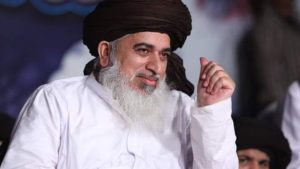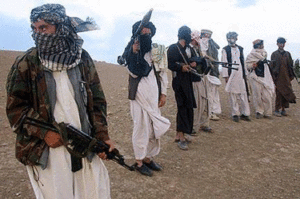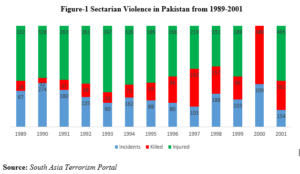by Mehmood Hussain 1/5/2018
Introduction

Until January 4, 2011 nobody was aware of Allama Khadim Hussain Rizvi, who later gained popularity for his firebrand style of oratory. Khadim Hussain Rizvi is a religious cleric born on June 22, 1966, in the Pindi Gheb area of Attock District Punjab. A Hafiz-e-Quran and Sheikh-ul-Hadith, Rizvi used to deliver Friday sermons at Lahore’s Pir Makki Masjid, located near Daata Darbar, during his stay in the Punjab Auqaf Department. Many mistake him as a Shia because of his last name, but he is a staunch follower of Imam Ahmed Raza Khan Barelvi, the 19th-century founder of the Barelvi sect.
Rizvi came into the limelight of media and political elite after his firm support for Mumtaz Qadri, a man who was supposed to protect the Governor of Punjab Salman Taseer, but he killed him in accusation of committing blasphemy through calling country’s most sensitive blasphemy law as a “black law.” Although large swathes of the citizenry condemned the act, Rizvi supported the murder and deeply involved in organizing public support for Section 295-C of the Pakistan Penal Code, which deals with blasphemy committed against Prophet Muhammad (PBUH). Since then he earned the nickname of “blasphemy activist” in religious circles. And after the execution of Mumtaz Qadri on February 29, 2016, some religious parties including the followers of Khadim Hussain Rizvi staged the protest against the act and blocked the D-Chowk. However, the protestors dispersed after negotiations with the authorities and claimed that government had accepted their demands including no change in the blasphemy law.
On October 2nd, 2017 the Federal Government of Pakistan led by Muslim League Nawaz (PML-N) passed the ‘Elections Act, 2017′ containing a controversial amendment in the nomination paper about the finality of Prophethood (Khatm-e-Nabuwat). In the previous bill, the nominated candidate ‘solemnly swear’ that I believe in the absolute and unqualified finality of the prophethood of Muhammad (PBUH), however in the new bill the government replaced the words “I solemnly swear” in Form-A with “I believe” in a clause relating to a candidate’s belief in the finality of the prophethood, which termed a suspected move of ruling party to allow Qadiani’s and Ahmedi’s to hold top positions in public offices. The said amendment sparked anxiety and antagonism in religious circles against the ruling party, and they demanded the sacking of federal law minister, who they believe was the suspect behind the amendment. But Khadim Hussain Rizvi was a most vocal person, and he organized various protests in Lahore and finally staged a three weeks long sit-in at Faizabad interchange Islamabad. Sunni Barelvi organizations such as; the Tehreek-i-Khatm-i-Nabuwwat, and the Sunni Tehreek Pakistan (ST) also supported the Rizvi and displayed their power in the capital.
After repeated abortive attempts to disperse the protestors, finally army intervened and brokered a deal between Tehreek Labbaik Ya Rasool Allah (TLYRA) and the federal government in which authorities accepted all the demands including the sacking of federal law minister Zahid Hamid and released the detainees captured during clashes with law enforcement agencies. TLYRA is a religious, political party set up by Rizvi and it proclaimed to counter every move of ruling PML-N. As earlier explained that Khadim Hussain Rizvi is a fiery preacher and repeatedly using abusive language while preaching, but numbers of his adherents are increasing day by day because he is using religion for political power. Therefore, against this backdrop, the primary objective of this article is to highlight the impacts of Khadim Hussain Rizvi and Barelvi sect’s rise on Pakistani society and state. The study intends to investigate that, to what extent Khadim Hussain Rizvi is radicalizing the youth of Pakistan, and will it be more violent than their predecessors? It argues that preaching style of Rizvi is more dangerous than the past religious parties and it is leading Pakistani society towards another episode of extremism and radicalism. It will give rise to sectarian violence and will damage the moderate and enlightened character of the country, which further increases the international pressure on Pakistan for religious tolerance. But before proceeding to highlight the impacts of Rizvi and Barelvi sect, it is pertinent to explain the roots of sectarian violence in Pakistan, which were sown during Zia era.
Afghan Jihad and Religious Extremism 1.0

The Soviet intervention in Afghanistan on the eve of December 25, 1979, and subsequent proxy war waged by the United States, Saudi Arabia, and Pakistan in the name of Jihad (Holy War) transformed the geopolitical and geostrategic landscape of South Asia in general and for Pakistan in particular. Pakistan was on the forefront and had been playing a pivotal role in Afghan resistance war, which not only forced Soviet forces to retreat from Afghanistan but also brought an end to the cold war rivalry between two superpowers. At the time of Afghan war, Pakistan was under the military rule of General Muhammad Zia ul Haq who was championing the Jihad in Afghanistan.
Zia devoted special attention to country’s premier intelligence agency ISI by appointing a Pashtun director Akhtar Abdur Rahman, better known as General Akhtar, who knew the Afghan world well. Pakistani ISI, American CIA, and Saudi GID developed a special trilateral relationship. The CIA and GID were bound to provide money and weapons to Afghan mujahedeen, and it was channeled through the ISI. Federally Administered Tribal Areas (FATA) were turned into training camps where around 85,000 hardcore mujahedeen were trained by 1988. During the Afghan war, ISI significantly increased its profile and developed close contacts with Islamic radicals to wage another jihad in Indian Occupied Kashmir. And the mid-1990s saw the increasing role of Pakistan based militant groups such as; Harkat-ul-Mujahideen (HuM), Lashkar-e-Taiba (LeT) and later Jaish-e-Mohammad (JeM).
President Zia transformed Pakistan and altered the course of its future more than anyone since Jinnah. He Islamized Pakistani military and society more than ever before and can be rightfully called the grandfather of global Islamic jihad. One measure of this transformation was ever growing mushrooming of Islamic schools or madrassas. Official numbers multiplied from 900 to 8,000 between 1971 and 1988 and another 25,000 unregistered ones. He aligned himself with the country’s Islamic Jammat-i-Islami party which not only offered human capital for Afghan Jihad but also assist Zia to Islamize Pakistan. For the first time in the history of Pakistan, the Islamists occupied important government positions. Thousands of party activists and sympathizers were appointed in the judiciary, the civil service, and educational institutions. These appointments strengthened the hold of the Islamists on crucial state apparatuses for many years to come.
Afghan war and the simultaneous Islamization process altered the sectarian fault lines in Pakistan, which alarmed the Shia minority. Meanwhile, the Islamic revolution in neighboring Iran by Shia’s increased the suspicion in Salafi Sheikhs of Saudi Arabia. The rival schools of thought in Riyadh and Tehran wanted to expand their monopoly in the Middle East, and Pakistan had no escape from this dirty game because the ruler Zia was leaned towards Saudi’s who were pouring massive economic assistance to their adherents in Pakistan. Therefore, to counter Saudi influence, Iran had also extended its helping hand to Shia minority in Pakistan which gave birth to lethal sectarian violence. Similarly, under the severe pressure of Sunni groups, Zia introduced the strict Sharia laws such as compulsory deduction of Zakat which sparked anger in Shia minority, and they refused compulsory deduction. However, to fully implement Sunni interpretation of Islam, armed wings of Sunni organizations used force, which increased the vulnerability to minority sects and non-believers. This clash of ideas and interpretation consumed thousands of ordinary lives which are continued to this day. Though soon after 9/11 attacks, President Pervez Musharraf made a daring move to end state patronage to these religious armed groups but the act of president provoked violent anger, and they started to target state installations including abortive assassination attempts on President Pervez Musharraf.

General Zia also introduced new sections into blasphemy law and introduced imprisonment and fine for an accused. In 1986, he introduced section 295C which particularly deal blasphemy committed against Prophet Muhammad (PBUH). According to section “Whoever by words, either spoken or written, or by visible representation or by any imputation, innuendo, or insinuation, directly or indirectly, defiles the sacred name of the Holy Prophet Muhammad (peace be upon him) shall be punished with death, or imprisonment for life, and shall also be liable to fine”. Though the section refers two punishments, however, Mullahs deliberately call for mandatory death to the accuser. Since 1987 to 2014, over 1,300 people have been accused of blasphemy, and the major incident took place in April 2017, when an angry mob of Abdul Wali Khan University Mardan killed a young student Mashal Khan over allegations of posting blasphemous content online, but none was proved blasphemous after scanning his social media accounts. Though the legislators made a law to prevent blasphemous acts against the religion and sacred personalities, it is used by individuals to settle their old accounts against their rivals.
Religious Extremism 2.0
Pakistan is a victim of terrorism and religious extremism since the Afghan war, and it lost thousands of innocent civilians. However, in recent years armed forces of Pakistan successfully managed to dismantle the terror network. And in the ongoing campaign military killed and captured hundreds of affiliates. But still needs a lot of work to eradicate radicalism from the society, which requires support from society and religious parties. Notwithstanding, despite enormous sacrifices of armed forces and the general public, religious extremism has been spreading in the country, and religious clerics are playing a dominant role. Similar can be predicted for future of Pakistan by Khadim Hussain Rizvi and his adherents. In the past, vandalism of Shia led Tahreek-i-Nafaz-Fiqah Jaafria and Sunni group Sipah-e-Sahaba Pakistan brutally killed innocent peoples.
Rizvi is a hardliner Sunni preacher and openly criticize the other school of thoughts. Since October 2017, he has increased his influence and his followers not only come from religious seminaries, but highly educated individuals are also supporting him. TLYRA is not only employing protests to gain support, but they are actively using social media to spread aberration.
Rizvi represents the rise of a new and more radical Berelvi sectarian movement. Berelvi represented the majority and considered “moderate” compared to those belonging to the hardline Deobandi and Wahabi school of Islam. However, radical clerics like Rizvi have turned militancy publically espousing violence in the name of their narrow view of religion. The group is now planning to jump into the 2018 general elections using the highly sensitive blasphemy issue to mobilize votes. The trailer of the radicalism has already been played in October 2017 siege when the protestors blocked twin cities and attacked law enforcement forces, and the civilian government capitulated in front of these radicals accepting all their demands.
TLYRA leader Khadim Hussain Rizvi and other participants were booked in a total of 27 criminal cases including for challenging the writ of the government, confronting and attacking law enforcement agencies personnel’s, damaging public property, and death of a nine-month-old child caused by the blockade. The Islamabad High Court (IHC) and Anti-Terrorism Court (ATC) issued the arrest warrants of Rizvi and others over their continued failure to appear before the courts in hearings for the sit-in. But till now police is reluctant to arrest the fiery cleric fearing a repeat of violent protests by armed cadres of the extremist religio-political outfit. Therefore, the failure exposes that individuals like Rizvi are above the state and have no fear of punishment and state surrender in their hands.
Conclusion
In the end, we only say that this is a beginning of another rise of religious extremism in Pakistan which will be more violent and destructive in future. Because the Mullahs and their followers are spreading hatred and animosity through the use of social media, which is almost ungovernable in the country. Though every sect has equal right and freedom to preach their views, they have no authority to spread hatred and intolerance. Therefore, it is dire need of time to equally suggest the civilian and military leadership to take immediate and appropriate measures to obstruct the spread of religious extremism which has already been distorting the state and society. The state must put hardliner mullahs under observation and restrict them to spread extremism. At the same time, political and military leadership stop offering patronage to extremists and fully implement the National Action Plan (NAP) to curb religious extremism and terrorism. State also regulate the madrassa system and source of income of religious clerics. An initial step has already been taken by the provincial government of KP by regulating madrassas and Imam Masjids, but it needs to expand across the country.
